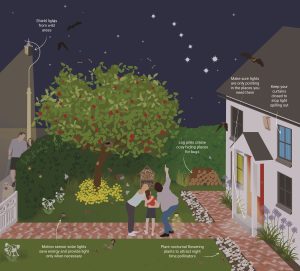
As we reach the longest day, Buglife, is calling for members of the public to join them in tackling one of the few remaining, socially acceptable pollutants – light pollution. Encouraging everyone to “Nurture the Night Shift” in an effort to increase awareness, spread the message and restore the natural rhythm of day and night for the benefit of all.
The new campaign, “Nurture the Night Shift”, focussing on light pollution and its detrimental effects on nocturnal bugs, seeks to enthuse people with nocturnal wildlife while carrying out simple actions to reduce the overuse of artificial light.
Support the campaign by delving into the free resources on the Buglife website, sharing your actions and night-time bug sightings across social media accompanied by the hashtag #NurtureTheNightShift. Whether you are turning off the outside lights, planting nocturnal flowers or spotting moths share your actions to spread the word.
 Light pollution, caused by excessive and misdirected artificial lighting, not only obstructs our view of the stars but also has serious consequences for nature. Light pollution disrupts natural rhythms, altering behaviour, navigation, and even the biology of nocturnal species.
Light pollution, caused by excessive and misdirected artificial lighting, not only obstructs our view of the stars but also has serious consequences for nature. Light pollution disrupts natural rhythms, altering behaviour, navigation, and even the biology of nocturnal species.
Most people are generally familiar with daytime bugs like bees and butterflies going about their lives, carrying out vital services such as pollination. But many don’t consider that an entire night shift takes over when the sun sets, with nocturnal bugs carrying out many of the same tasks as the animals we see during the day such as pollination, recycling nutrients, and controlling pests.
Two-thirds of invertebrates are partially or wholly nocturnal, dependent on the trigger of darkness to carry out their important roles. But what happens if daylight never ends? Light pollution is now thought to be increasing globally by 10% every year, and bugs and other nocturnal wildlife are now faced with constant light preventing them from carrying out their vital roles.
The nature of light pollution presents a unique solution. It is a form of pollution that can be solved, quickly, inexpensively, and effectively using existing technologies and practices. Once a light has been turned off, that pollution no longer exists – unlike issues such as water quality, plastics, pesticides, and toxic air.
Nurture the Night Shift
As well as reducing their own impacts from light pollution, Buglife are encouraging the public to go Bug-gazing and appreciate some of the incredible nocturnal bugs we share our gardens and wild spaces with. They want gardeners to consider the “night garden” and how small changes such as shutting the curtains when the lights are on, using motion sensors, planting nocturnal flowering plants, and leaving wild areas of the garden can help natural night life thrive. They have also developed a simple guide to Bug-friendly lighting. Considering the need, amount, duration, and direction of lighting can mean huge differences to our smallest creatures and any improvement in current lighting will help nurture the night shift.
Craig Macadam, Conservation Director at Buglife, shared, “We want the widespread love of daytime pollinators to extend to the night to recognise and celebrate the huge variety of bugs that are busy when the sun goes down. Insects are in decline, and this includes those active at night, they face many of the same challenges as daytime species such as habitat loss, climate change and the use of chemicals, but also, they have the extra pressure of light pollution changing the natural rhythm.”
David Smith, Advocacy and Social Change Officer at Buglife, added, “We need to treat light in the same regard as other pollutants and bring it under control. Simple changes such as shutting curtains when the lights are on, switching to timers and motion sensors and reducing the brightness of lights can help wildlife to thrive while still providing lighting when we need to use it. Addressing light pollution can also bring further benefits such as reducing energy consumption and allowing a better view of the night sky.”
- Research published in 2023 reveals a rapid increase in global light pollution levels by 10% every year for the past decade, representing a doubling of sky brightness every 8 years.
- One-third of insects attracted to streetlights and other fixed light sources will die as a consequence.
- Caterpillar populations declined by 52% in areas with streetlights. Evidence also shows diverse impacts of artificial light across most life stages and key behaviours of moths.
- Light pollution is reducing nocturnal pollinator visits to flowers, by 62% in some areas.
- Glow-worms use luminescence to attract prey and to attract mates and therefore rely on darkness. Evidence shows a decline in Glow-worm populations with increased proximity to artificial light.
 Nurture the Night Shift is a collection of free resources available via Buglife’s website: www.buglife.org.uk/campaigns/light-pollution/
Nurture the Night Shift is a collection of free resources available via Buglife’s website: www.buglife.org.uk/campaigns/light-pollution/
We are calling on everyone to help us #NurtureTheNightShift, to support nocturnal wildlife going about their lives playing vital roles in our ecosystems; we hope that the new resources will help people engage with and protect nocturnal wildlife in their gardens.
There are three simple actions/ways for people to get involved:
Main Image: Coastal Light Pollution © Grace Miller @gracemiller_photography

